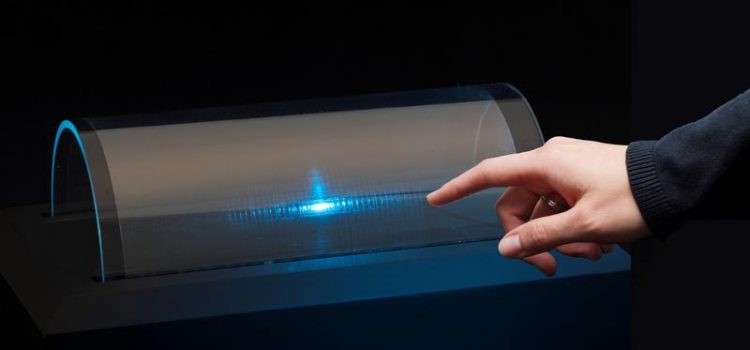Hannover Messe: Inkjet process to print flexible touchscreens cost-efficiently

Printed, flexible touchscreen. Sourec: INM, free within this press release
Flexible smart phones are desirable for a lot of users. Up to now the displays of the innumerable phones and pods are rigid and do not yield to the anatomical forms adopted by the people carrying them. By now it is no longer any secret that the big players in the industry are working on flexible displays.
INM – Leibniz Institute for New Materials shows, how they might become reality in the near future: At this year’s Hannover Messe, INM will be presenting suitable coatings for cost-efficient inkjet processes at the stand B46 in hall 2 from on 24 April to 28 April.
INM will be demonstrating flexible touch screens, which are produced by printing recently developed nanoparticle inks on thin plastic foils. These inks composed predominantly of transparent, conductive oxides (TCOs) are suitable for a one-step printing process. Thus transparent lines and patterns are obtained by inkjet printing or alternatively by direct gravure printing, which are electrically conductive even after bending. Thus, a one-step-printing process for cost-efficient electrode patterns is enabled.
Conductive coatings with TCOs are usually applied by means of high vacuum techniques such as sputtering. For patterning of the TCO coatings additional cost-intensive process steps are necessary, for example photolithography and etching.
“We use the TCOs to produce nanoparticles with special properties,” explains Peter William de Oliveira, Head of the Optical Materials Program Division. “The TCO ink is then created by adding a solvent and a special binder to these TCO particles.
The binder performs several tasks here: it not only makes the TCO nanoparticles adhere well on the substrate; it also increases the flexibility of the TCO coating: in this way, the conductivity is maintained even when the films are bent.
Using an adapted electrode pattern, flexible capacitive touch screen sensors with high sensitivity and resolution can thus be printed in a simple process”. After curing under UV light at low temperatures less than 130 degrees centigrade, the coating is completed.
The transparent, electronically conductive inks allow conductor tracks to be produced easily even on classic reel-to-reel processes. Initial trials at INM have been promising. The researchers all agree that the use of structured rollers will in the future allow structured, conductive surfaces to be printed with a high throughput at low cost.
Your expert at INM
Dr. Peter William de Oliveira
INM – Leibniz Institute for New Materials
Head Optical Materials
Head InnovationCenter INM
Phone: +49681-9300-148
OptiMat@leibniz-inm.de
INM – Leibniz Institute for New Materials, situated in Saarbrücken, is an internationally leading centre for materials research. INM conducts research and development to create new materials – for today, tomorrow and beyond. Research at INM is performed in three fields: Nanocomposite Technology, Interface Materials, and Bio Interfaces. INM is an institute of the Leibniz Association and has about 240 employees.
Media Contact
All latest news from the category: Trade Fair News
Newest articles

Superradiant atoms could push the boundaries of how precisely time can be measured
Superradiant atoms can help us measure time more precisely than ever. In a new study, researchers from the University of Copenhagen present a new method for measuring the time interval,…

Ion thermoelectric conversion devices for near room temperature
The electrode sheet of the thermoelectric device consists of ionic hydrogel, which is sandwiched between the electrodes to form, and the Prussian blue on the electrode undergoes a redox reaction…

Zap Energy achieves 37-million-degree temperatures in a compact device
New publication reports record electron temperatures for a small-scale, sheared-flow-stabilized Z-pinch fusion device. In the nine decades since humans first produced fusion reactions, only a few fusion technologies have demonstrated…





















